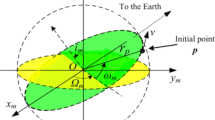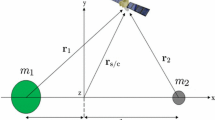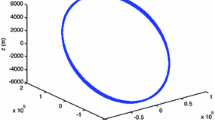Abstract
Quasi-periodic orbits around the libration point orbits have attracted significant attention since they can provide more opportunities for space missions. This paper proposes a variable step-size multistep method that can effectively calculate long-term quasi-periodic orbits around the Sun-Earth \(L_{1}\)/\(L_{2}\) in the Sun-Earth-Moon bicircular model. In this method, periodic orbits in the Sun-Earth \(L_{1}\)/\(L_{2}\) serve as the initial reference trajectories for quasi-periodic orbits. Then a two-level multiple shooting is introduced to transition periodic orbits to the short-term quasi-periodic orbits. Finally, a variable step-size multistep method is proposed to obtain long-term quasi-periodic orbits based on the approximately linear relationship between the two-level multiple shooting method and step size. Numerical results show that this method can effectively obtain a large set of long-term quasi-periodic orbits whether the quasi-periodic orbits have free or fixed initial positions. Furthermore, this method is also extended to design long-term quasi-periodic orbits with differential phase angles of the Moon.


Similar content being viewed by others
References
Akiyama, Y., Bando, M., Hokamoto, S.: Periodic and quasi-periodic orbit design based on the center manifold theory. Acta Astronaut. 160, 672–682 (2019)
Akp, A., Eia, B., Rk, C.: Effect of moon perturbation on the energy curves and equilibrium points in the Sun–Earth–Moon system. New Astron. 84 (2020)
Baresi, N., Olikara, Z.P., Scheeres, D.J.: Fully numerical methods for continuing families of quasi-periodic invariant tori in astrodynamics. J. Astronaut. Sci. 65(2), 157–182 (2018)
Davis, K.E., Anderson, R.L., Scheeres, D.J., et al.: Optimal transfers between unstable periodic orbits using invariant manifolds. Celest. Mech. Dyn. Astron. 109(3), 241–264 (2011). https://doi.org/10.1007/s10569-010-9327-x
DeFilippi, G. Jr: Station keeping at the l4 libration point: a three dimensional study. Thesis, Air Force Inst. Of Tech (1977)
Dunham, D.W., Jen, S., Roberts, C., et al.: Transfer trajectory design for the SOHO libration-point mission. In: International Astronautical Federation Congress, Washington, DC (1992)
Dutt, P., Anilkumar, A., George, R.: Design and analysis of weak stability boundary trajectories to moon. Astrophys. Space Sci. 363(8), 161 (2018)
Farquhar, R.W., Kamel, A.: Quasi-periodic orbits about the translunar libration point. Celest. Mech. 7(4), 458–473 (1973)
Farquhar, R.W., Dunham, D.W., Guo, Y., et al.: Utilization of libration points for human exploration in the Sun–Earth–Moon system and beyond. Acta Astronaut. 55(3), 687–700 (2004). https://doi.org/10.1016/j.actaastro.2004.05.021
Folta, D., Woodard, M., Cosgrove, D.: Stationkeeping of the first Earth-Moon libration orbiters: the Artemis mission. In: Proceedings of the AAS/AIAA Astrodynamics Specialist Conference, AAS 11-515, AAS (2011)
Gómez, G., Masdemont, J., Simó, C.: Quasihalo orbits associated with libration points. J. Astronaut. Sci. 46(2), 135–176 (1998)
Gomez, G., Jorba, A., Masdemont, J.J., et al.: Dynamics and Mission Design Near Libration Points, Vol. III: Advanced Methods for Collinear Points, vol. 4. World Scientific, Singapore (2001)
Guo, Q., Lei, H.: Families of Earth–Moon trajectories with applications to transfers towards Sun–Earth libration point orbits. Astrophys. Space Sci. 364(3), 43 (2019)
Guzzetti, D., Bosanac, N., Haapala, A., et al.: Rapid trajectory design in the Earth–Moon ephemeris system via an interactive catalog of periodic and quasi-periodic orbits. Acta Astronaut. 126, 439–455 (2016)
Gómez, G., Howell, K., Masdemont, J., et al.: Station-keeping strategies for translunar libration point orbits. Adv. Astronaut. Sci. 99(2), 949–967 (1998)
Hechler, M., Cobos, J.: Herschel, Planck and Gaia Orbit Design pp. 115–135. World Scientific, Singapore (2003)
Howell, K., Pernicka, H.: Numerical determination of Lissajous trajectories in the restricted three-body problem. Celest. Mech. 41(1–4), 107–124 (1987). https://doi.org/10.1007/BF01238756
Hénon, M.: Numerical exploration of the restricted problem. V: Hill’s case: Periodic orbits and their stability. Astron. Astrophys. 1 (1969)
Hénon, M.: A family of periodic solutions of the planar three-body problem, and their stability. Celest. Mech. 13(3), 267–285 (1976)
Ilin, I., Tuchin, A.: Quasi-periodic orbits in the vicinity of the sun-earth system l2 point and their implementation in “spectr-rg” and “millimetron” missions. In: Proceedings of the International Astronautical Congress, IAC, pp. 5286–5292 (2014)
Ilyin, I.: Quasi-periodic orbits around Sun-Earth l 2 libration point and their transfer trajectories in Russian space missions. Thesis (2015)
Jin, Y., Xu, B.: Three-maneuver transfers from the cislunar l2 halo orbits to low lunar orbits. Adv. Space Res. 69(2), 989–999 (2022)
Jorba, A., Masdemont, J.: Dynamics in the center manifold of the collinear points of the restricted three body problem. Phys. D: Nonlinear Phenom. 132(1–2), 189–213 (1999)
Kolemen, E., Kasdin, N.J., Gurfil, P.: Multiple Poincaré sections method for finding the quasiperiodic orbits of the restricted three body problem. Celest. Mech. Dyn. Astron. 112(1), 47–74 (2012). https://doi.org/10.1007/s10569-011-9383-x
Koon, W.S., Lo, M.W., Marsden, J.E., et al.: Dynamical Systems, the Three-Body Problem and Space Mission Design. Springer, New York (2011)
Lara, M.: A Hopf variables view on the libration points dynamics. Celest. Mech. Dyn. Astron. 129(3), 285–306 (2017). https://doi.org/10.1007/s10569-017-9778-4
Lara, M., Pérez, I.L., López, R.: Higher order approximation to the hill problem dynamics about the libration points. Commun. Nonlinear Sci. Numer. Simul. 59, 612–628 (2018). https://doi.org/10.1016/j.cnsns.2017.12.007
Lo, M., Ross, S.: The lunar l1 gateway: portal to the stars and beyond. In: AIAA Space 2001 Conference and Exposition, A01-40254 (2001). https://doi.org/10.2514/6.2001-4768
Lo, M., Williams, B., Bollman, W., et al.: Genesis mission design. In: AIAA/AAS Astrodynamics Specialist Conference and Exhibit, p. 4468 (1998)
Lorenzini, E., Cosmo, M., Kaiser, M., et al.: Mission analysis of spinning systems for transfers from low orbits to geostationary. J. Spacecr. Rockets 37(2), 165–172 (2000). https://doi.org/10.2514/2.3562
Lujan, D., Scheeres, D.J.: The Earth-Moon l2 quasi-halo orbit family: characteristics and manifold applications. In: AIAA SCITECH 2022 Forum, p. 2459 (2022)
Marchand, B.G., Howell, K.C., Wilson, R.S.: Improved corrections process for constrained trajectory design in the n-body problem. J. Spacecr. Rockets 44(4), 884–897 (2007)
McCarthy, B.P., Howell, K.C.: Trajectory design using quasi-periodic orbits in the multi-body problem. In: Proceedings of the 29th AAS/AIAA Space Flight Mechanics Meeting (2019)
McCarthy, B.P., Howell, K.C.: Leveraging quasi-periodic orbits for trajectory design in cislunar space. Astrodynamics 5(2), 139–165 (2021)
Mingotti, G., Topputo, F., Bernelli-Zazzera, F.: Transfers to distant periodic orbits around the moon via their invariant manifolds. Acta Astronaut. 79, 20–32 (2012)
Neelakantan, R., Ramanan, R.: Design of multi-revolution orbits in the framework of elliptic restricted three-body problem using differential evolution. J. Astrophys. Astron. 42(1), 1–18 (2021)
Olikara, Z.P., Scheeres, D.J.: Numerical method for computing quasi-periodic orbits and their stability in the restricted three-body problem. Adv. Astronaut. Sci. 145(911–930) (2012a)
Olikara, Z.P., Scheeres, D.J.: Numerical method for computing quasi-periodic orbits and their stability in the restricted three-body problem. Adv. Astronaut. Sci. 145(911–930), 911–930 (2012b)
Parker, J.S., Anderson, R.L.: Low-Energy Lunar Trajectory Design, vol. 12. Wiley, New York (2014)
Parker, J.S., Davis, K.E., Born, G.H.: Chaining periodic three-body orbits in the Earth–Moon system. Acta Astronaut. 67(5–6), 623–638 (2010)
Qi, R., Xu, S.: Optimal low-thrust transfers to lunar l1 halo orbit using variable specific impulse engine. J. Aerosp. Eng. 28(4), 04014096 (2015)
Qu, Q., Xu, M., Peng, K.: The cislunar low-thrust trajectories via the libration point. Astrophys. Space Sci. 362(5), 96 (2017). https://doi.org/10.1007/s10509-017-3075-2
Ramteke, V., Kumar, S.R.: Halo orbit maintenance around l 1 point of the Sun-Earth system using optimal control and Lyapunov stability theory. J. Aerosp. Eng. 35(1), 04021107 (2022)
Richardson, D.L.: Analytic construction of periodic orbits about the collinear points. Celest. Mech. 22(3), 241–253 (1980). https://doi.org/10.1007/BF01229511
Richardson, D.L.: Halo orbit formulation for the isee-3 mission. J. Guid. Control Dyn. 1(6), 543–548 (2012)
Shahid, K., Kumar, K.D.: Nonlinear station-keeping control in the vicinity of the Sun-Earth l 2 point using solar radiation pressure. J. Aerosp. Eng. 29(3), 04015073 (2016)
Sousa-Silva, P., Terra, M.O., Ceriotti, M.: Fast Earth–Moon transfers with ballistic capture. Astrophys. Space Sci. 363(10), 210 (2018)
Tang, G., Jiang, F.: Capture of near-Earth objects with low-thrust propulsion and invariant manifolds. Astrophys. Space Sci. 361(1), 1–14 (2016). https://doi.org/10.1007/s10509-015-2592-0
Wang, Q., Liu, J.: A Chang’e-4 mission concept and vision of future Chinese lunar exploration activities. Acta Astronaut. 127, 678–683 (2016)
Woodard, M., Folta, D., Woodfork, D.: Artemis: the first mission to the lunar libration orbits. In: 21st International Symposium on Space Flight Dynamics, Toulouse, France (2010)
Xu, M., Tan, T., Xu, S.: Research on the transfers to halo orbits from the view of invariant manifolds. Sci. China, Phys. Mech. Astron. 55(4), 671–683 (2012). https://doi.org/10.1007/s11433-012-4680-2
Yadav, A.K., Kushvah, B.S., Dolas, U.: Lissajous motion near Lagrangian point l2 in radial solar sail. J. Astrophys. Astron. 39(6) (2018)
Yang, C., Peng, H., Tan, S., et al.: Improved time-varying controller based on parameter optimization for libration-point orbit maintenance. J. Aerosp. Eng. 29(1), 04015010 (2016)
Yingjing, Q., Xiaodong, Y., Wuxing, J., et al.: An improved numerical method for constructing Halo/Lissajous orbits in a full solar system model. Chin. J. Aeronaut. (2018). https://doi.org/10.1016/j.cja.2018.03.006
Zaborsky, S.: Generating solutions for periodic orbits in the circular restricted three-body problem. J. Astronaut. Sci. (4) (2020)
Zimmer, A.: Investigation of vehicle reusability for human exploration of near-Earth asteroids using Sun–Earth libration point orbits. Acta Astronaut. 90(1), 119–128 (2013). https://doi.org/10.1016/j.actaastro.2012.10.003
Acknowledgements
We acknowledge support from the National Natural Science Foundation of China (Grants No. 12102344) and the National Key Laboratory of Aerospace Flight Dynamics.
Author information
Ethics declarations
Competing interests
The authors declare no competing interests.
Additional information
Publisher’s Note
Springer Nature remains neutral with regard to jurisdictional claims in published maps and institutional affiliations.
Rights and permissions
Springer Nature or its licensor holds exclusive rights to this article under a publishing agreement with the author(s) or other rightsholder(s); author self-archiving of the accepted manuscript version of this article is solely governed by the terms of such publishing agreement and applicable law.
About this article
Cite this article
Tan, M., Ma, B. & Li, H. A multi-step method to calculate long-term quasi-periodic orbits around the Sun-Earth \(L_{1}\)/\(L_{2}\). Astrophys Space Sci 367, 101 (2022). https://doi.org/10.1007/s10509-022-04135-5
Received:
Accepted:
Published:
DOI: https://doi.org/10.1007/s10509-022-04135-5


















